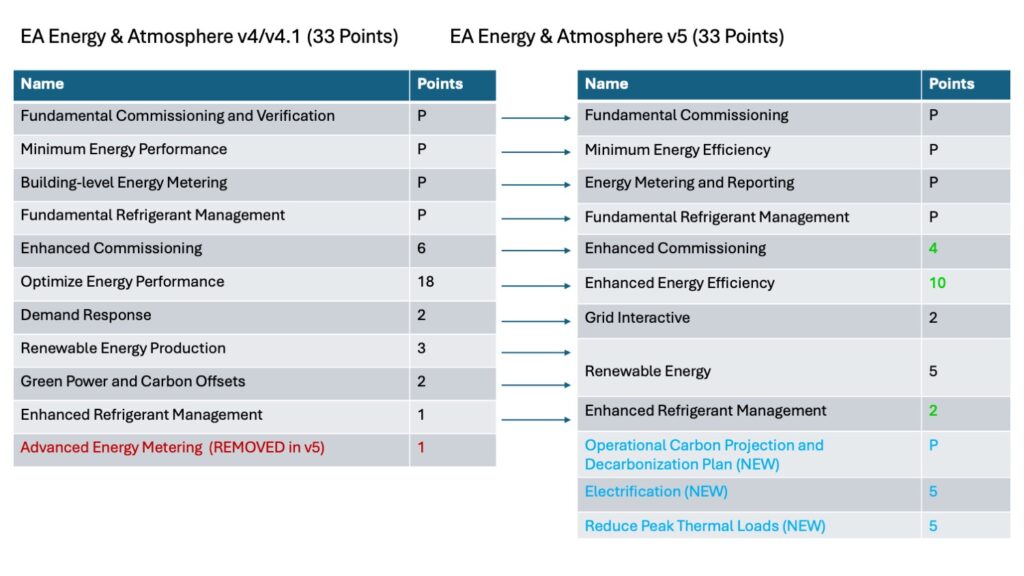
Written By: Paul Conrad, Catalyst Partners
After years of navigating LEED v4 and the incremental updates of v4.1, the U.S. Green Building Council (USGBC) has officially released the full balloted text and reference guide for LEED Version 5. Here’s what project teams need to know moving forward in the Energy and Atmosphere (EA) category.
New and Revised Prerequisites
There is a brand new Energy and Atmosphere prerequisite, called Operation Carbon Projection and Decarbonization Plan. It’s primary purpose appears to be stimulating the project team to consider carbon impacts early in the design process. As such, it will require an early design analysis focused on efficiency improvements, peak load reduction, and decarbonization measures. Once you complete your analysis, you add an estimate of site energy, then make a carbon projection based on that information. Once you have your Business as Usual (BAU) carbon projection, the project team will either earn 4 or 5 points in EAc1 Electrification, or provide a 2 page (maximum) plan for decarbonization.
The remaining prerequisites will be familiar to LEEDv4/v4.1 users, however there are a few revisions to be aware of:
- Minimum Energy Performance
- The standard has been updated. Your compliance can be based on ASHRAE 90.1-2019 or 2022. ASHRAE 90.1-2022 will automatically become the required standard after January 1st, 2028.
- Prerequisite compliance may be demonstrated via the Prescriptive Method, Section 11, or Appendix G.
- Fundamental Commissioning
- Projects are now required to comply with the Commissioning requirements of ASHRE 90.1 in Section 4.2.5.
- There are additional LEED-only commissioning requirements, most of which will be familiar. However, a submittal review is now required for Fundamental Commissioning.
- Energy Metering and Reporting
- Projects are now required to comply with the metering requirements of ASHRAE 90.1.
- Fundamental Refrigerant Management
- No longer just a “no-CFCs” checkbox
- Projects teams must:
- Complete a refrigerant inventory
- HCFCs are not allowed
- Evaluate alternatives for refrigerants with a global warming potential (GWP) of more than 700
- Complete a leak check and repair prior to substantial completion
New Credits – Electrification and Peak Load Reduction
There are two new Energy and Atmosphere credits for version 5. They are EAc1: Electrification and EAc2: Reduce Peak Thermal Loads.
The new electrification credit has two Options; No On-site Combustion and No On-site Combustion except at low temperatures (below 20 degrees F). For No On-site Combustion, the project team must design without on-site combustion sources (emergency support systems aka generators are exempt) and the combined weighted average of space heating and service hot water heating systems must be at least 1.8 COP. The intent is to encourage the installation of Heat Pump heating systems, rather than allow electric resistance heat to be installed in the name of decarbonization.
For Option 2 No On-site Combustion except at low temperatures (below 20 degrees F), there are requirements for each system type individually to earn credit. Space Heating, Service Water Heating, and Cooking/Process loads can each demonstrate that they use no on-site combustion sources.
The new Reduce Peak Thermal Loads credit is a complicated process with multiple options for things like:
- Infiltration and Balanced Ventilation
- Ventilation Energy Recovery
- Thermal Bridging
- Peak Thermal loads reduction through Calculations/Energy Modeling
This new credit is based on a LEEDv4 Pilot Credit aimed at designing buildings that require smaller sized HVAC equipment, achieving carbon savings both in equipment and operation.
Revised Credits
The remaining Energy and Atmosphere credits will again be familiar to project teams that have submitted LEED version 4 and 4.1 projects, however there have been some updates and revisions that should be noted.
- Enhanced Energy Efficiency
- Reduced in points from 18 to 10, points were redistributed to the new credits.
- Modeling and Prescriptive options, both based on ASHRAE 90.1-2019/2022.
- ASHRAE version based on EAp2 Minimum Energy Performance requirements
- Two points scales for modeling method, one with renewable energy and one without. This means no more double dipping of points in both the model and renewable energy.
- Renewable Energy
- Similar to the LEED v4.1 methodology
- Enhanced Commissioning
- Reduced in max points obtainable from 5 to 4.
- Compliance for Enhanced Commissioning for MEP systems based on ASHRAE 202-2024
- Compliance for Enhanced Commissioning for Building Enclosure based on ASTM E2947-21A except 7.2.4 and 7.4.3
- Additional LEED-only requirements.
- Monitoring based commissioning requirements are independent of MEP and Enclosure, with multiple paths dependent on monitoring software.
- Grid Interactive
- Redesigned and integrated combination of Advanced Metering and Demand Response credits from LEEDv4.
- Multiple options to demonstrate resilience and demand response strategies and technologies.
- Enhanced Refrigerant Management
- Up to two points
- The refrigerant impact calculation has been redesigned to be more stringent and better account for different system types and refrigerants. Benchmarks are set and a new calculator is coming to assist with compliance.
Conclusion
At the end of the day there are a few important takeaways from the updated version of LEED:
- Alignment with National Standards
USGBC has strategically aligned LEED v5 with broader industry codes and standards, lending greater consistency and credibility to the rating system. - Increased Stringency
Unlike LEED v4, which became easier to achieve over time, LEED v5 raises the bar significantly. It rewards projects that demonstrate leadership in carbon reduction and climate resilience. - Five-Year Update Cycle
USGBC’s commitment to a regular 5-year update cycle signals a new, adaptable framework. LEED v5 sets a strong template for future versions to evolve without a full redesign.
For project teams, LEED v5 opens new pathways to promote decarbonization, resiliency, and climate-forward design — encouraging integrated, thoughtful building strategies from the very first stages of design.





